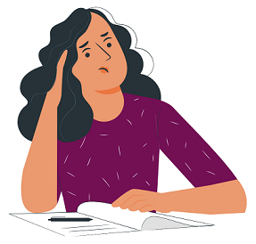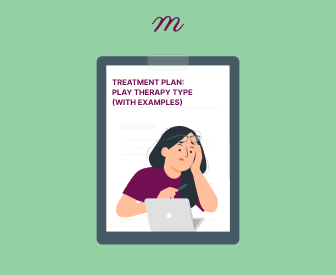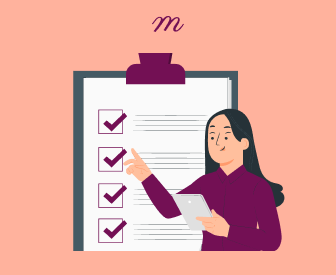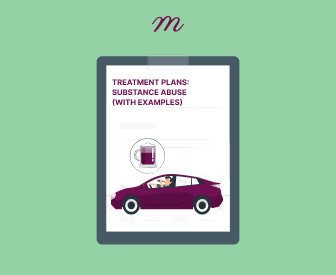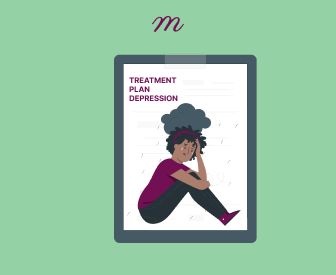Have your progress notes written for you automatically
Eating disorders are often very complex and affect multiple parts of a person’s life. For many, food is not just food; it is security, punishment, or even a means of self-expression. It is a complex interplay of psychological, biological, and social factors, making recovery a difficult but achievable process.That’s why a structured treatment plan for eating disorders is essential.
It provides patients with a roadmap for recovery, balancing structure with flexibility. The goal isn’t just stopping behaviors like restriction, binging, or purging; it’s rebuilding a patient’s relationship with food, their body, and themselves. A well-defined plan offers a sense of direction, fostering a collaborative approach between the therapist and the patient. It also allows for consistent monitoring and adjustments as the patient progresses.
Let’s walk through how to create an effective treatment plan for eating disorders—one that is evidence-based, patient-centered, and adaptable. To illustrate, we’ll follow Jane, a 20-year-old woman struggling with anorexia nervosa, through each phase of the treatment plan.
Creating an Effective Treatment Plan for Eating Disorders
1. Laying the Groundwork: Initial Assessment & Goal Setting
Before diving into a treatment plan for eating disorders, a comprehensive assessment is crucial. Eating disorders are different from each other, and depending on the symptoms, one diagnosis may be more accurate than another. In addition, they can often involve other symptoms or disorders. The assessment phase also helps determine the severity and risk level, guiding treatment decisions and ensuring the most appropriate care.
Jane, a university student, arrived at her first session reluctantly. She had lost a significant amount of weight in the past year, avoiding social events involving food and obsessing over calorie intake. Her parents, worried about her health, encouraged her to seek help.
- Medical Monitoring: The patient’s physical health is assessed, including vital signs, weight, and lab tests (electrolytes, liver/kidney function, thyroid, iron, vitamin D, and blood count). This evaluation identifies the eating disorder’s physical impact and any medical complications. Collaboration with a medical doctor or psychiatrist is recommended.
- Psychological Screening: Standardized questionnaires (e.g., EDE-Q, SCOFF) and clinical interviews evaluate eating disorder symptoms, behaviors, and beliefs. These tools identify the specific eating disorder, its severity, and any co-occurring mental health conditions.
- Identifying Risk Levels: The assessment determines the appropriate level of care and specific needs. Risk factors include medical instability, suicidality, severe malnutrition, and lack of social support.
- Assessing Cognitive Rigidity: The presence of rigid, black-and-white thinking, particularly concerning food and body image, is evaluated. Understanding these thought patterns is crucial for creating a treatment plan for eating disorders.
- Exploring Co-occurring Disorders: Assessment for other mental health conditions (e.g., depression, anxiety, OCD, PTSD, substance use disorders) is conducted, as these can significantly impact treatment.
- Social and Family History: The patient’s social support, family dynamics, and any history of trauma or abuse are explored to provide valuable context for treatment.
In our example, Jane’s lab tests showed low iron and mild electrolyte imbalances, so her doctor recommended regular check-ups. The EDE-Q and the SCOFF showed moderate restriction and body image concerns. She also struggled with anxiety, perfectionism, and rigid thinking about food and weight. Her family dynamics were somewhat strained, and she lacked strong social support, which could make recovery harder.
Treatment Plan for Eating Disorders: Defining Recovery Goals
One of the most effective ways to help patients feel less overwhelmed is by breaking down recovery into tangible steps. These goals should be SMART (Specific, Measurable, Achievable, Relevant, and Time-bound).
To make progress feel manageable, Jane and her team set short- and long-term goals like:
- Short-term Goals:
- “Eat three structured meals and two snacks daily for the next two weeks.”
- “Reduce body-checking behaviors by half in the next month.”
- “Identify and challenge one negative thought about body image each day for a week.”
- Long-term Goals:
- “Be able to eat socially without fear by the end of treatment.”
- “Achieve and maintain a healthy weight.”
- “Develop a positive body image.”
- “Engage in activities and relationships that are not centered around food or body image.”
Teamwork Matters
A strong treatment plan for eating disorders includes different specialists:
- The therapist helps with thoughts, emotions, and behaviors linked to the eating disorder. They may use different types of therapy.
- A dietitian creates meal plans, supports nutrition, and helps patients face food fears while building a healthy relationship with eating.
- The doctor and/or psychiatrist checks medical stability, manages health issues, and prescribes medication if needed.
- A family therapist (if involved) helps improve communication and family support, which is especially important for children and teenagers.
2. Behavioral Interventions: Changing Eating Habits
Patients with eating disorders often follow strict, rule-based eating habits. The first step in treatment is to establish regular, balanced eating patterns and break harmful cycles so they can build the stability and strength needed to tackle deeper emotional and psychological challenges.
Creating Structured Eating Patterns
Eating disorders thrive in chaos; structured eating reestablishes rhythm and reduces anxiety around food.
- Personalized Meal Plans: Each patient needs a different approach. Some require strict meal plans, while others gradually move toward intuitive eating. A dietitian helps create a plan that fits their needs.
- Stopping Binge-Restrict Cycles: Eating regularly throughout the day prevents extreme hunger, keeps blood sugar stable, and lowers the risk of bingeing.
- Regular Meal Times: Eating meals and snacks at set times helps the body recognize hunger and fullness naturally.
- Portion Control: Learning proper portion sizes helps patients feel more comfortable with food, avoiding both overeating and feeling deprived.
Jane’s structured eating plan includes a personalized meal schedule to ensure balanced nutrition and prevent extreme hunger. By eating at regular times and learning proper portion sizes, she can reduce food anxiety, regain energy, and build a healthier relationship with food.
Exposure Therapy for Fear Foods
Many patients have “safe” and “fear” foods. Slowly introducing feared foods helps them reduce avoidance and challenge negative beliefs.
- Creating a Food List: The dietitian and therapist help the patient list feared foods, ranking them from least to most scary.
- Step-by-Step Exposure: The patient starts with small portions of easier foods and gradually tries more challenging ones.
- Real-Life Practice: A therapist might even join the patient at a restaurant or help them order takeout to practice eating in everyday situations.
Jane had a long list of “forbidden” foods, including pasta, desserts, and fried items. Her therapist and dietitian can help her create a hierarchy of feared foods like this one (from least to most scary):
- Whole wheat bread
- Fries
- Pasta
- Ice cream
She would start by adding a small portion of bread to her meals, slowly working her way up to more challenging foods. After weeks of practice, she would eventually eat an ice cream with her friends. A great step!
Mindful & Flexible Eating
Learning to eat more intuitively means shifting from strict food rules, like “I can’t eat after 7 PM,” to listening to the body and asking, “What do I need right now?” It involves recognizing the difference between physical hunger and emotional eating triggers. Patients are encouraged to eat slowly and mindfully, paying attention to their body’s signals of fullness. They also work on identifying and challenging rigid food rules, allowing for a more flexible and balanced approach to eating.
3. Addressing Cognitive Distortions: Restructuring Thoughts
Many people with eating disorders struggle with distorted thoughts about food, weight, and self-esteem. Cognitive restructuring is key in the treatment.
Enhanced Cognitive-Behavioral Therapy (CBT-E) Techniques
CBT-E (Enhanced Cognitive Behavioral Therapy) is a type of therapy designed specifically for eating disorders. It helps people understand and change the unhelpful thoughts and behaviors that keep them stuck in harmful eating patterns. Instead of following strict food rules or negative beliefs about their body, they learn to challenge those thoughts and build a healthier relationship with food. CBT-E is flexible and personalized, helping each person work through both their eating struggles and the emotions behind them. Some techniques are:
- Identifying Cognitive Distortions: Common thinking mistakes include all-or-nothing thinking, catastrophizing, taking things too personally, and ignoring the positives.
- Thought Records: Patients track their thoughts, feelings, and behaviors related to food and body image to find patterns and challenge negative thinking.
- Reframing Beliefs: With their therapist, they work on replacing harmful beliefs with more realistic and balanced thoughts.
Jane believes that eating carbohydrates causes instant weight gain. With her therapist’s help, she will use CBT-E techniques to challenge this belief. She will identy her all-or-nothing thinking and perfectionism, tracking irrational thoughts, and work on replacing them with more balanced ones. Over time, she will shift from thinking, “Carbs make me fat” to “Carbs fuel my body and help me think clearly.”
Body Image Work
Struggling with body image is a common challenge for people with eating disorders. Therapy helps them develop a healthier relationship with their body by challenging negative thoughts and unrealistic standards.
- Mirror Exposure Therapy: Patients gradually face their body image fears in a safe setting, learning to tolerate discomfort and challenge negative self-perceptions.
- Media Literacy: They learn to question unrealistic beauty standards shown in the media and recognize how these messages impact their self-image.
- Developing Self-Compassion: Patients practice being kinder to themselves, understanding that everyone has insecurities and that their worth isn’t defined by appearance.
Jane avoids mirrors, fearing they will confirm her worst thoughts about herself. Through mirror exposure therapy, she can gradually increase her tolerance, starting with brief glances and progressing to full-body reflections without judgment.
Shifting Identity Beyond the Disorder
Many patients wonder, “Who am I without my eating disorder?” Therapy helps them discover new identities and values.
- Building Stronger Relationships: Learning to connect with family and friends in healthy ways.
- Finding Purpose Beyond Food and Body Image: Exploring hobbies, interests, and activities that bring happiness and meaning.
- Boosting Self-Worth: Developing confidence that isn’t based on weight or appearance.
4. Emotional Regulation & Trauma Work
Many eating disorders are rooted in emotional dysregulation and trauma. Addressing these underlying issues once eating habits and symptoms have improved is essential.
Emotional Coping
Many people with eating disorders use food or restriction to manage overwhelming emotions. Therapy should focus on building healthier coping strategies to replace these patterns and gain the stability they need for long-term healing.
- Recognizing Triggers: Identifying emotions like stress, shame, or anxiety that drive disordered eating can help break the cycle.
- Building Emotional Tolerance: Learning to tolerate discomfort through mindfulness, grounding exercises, and distress tolerance skills can reduce impulsive behaviors.
- Finding Better Coping Strategies: Encouraging alternatives like journaling, movement, or creative outlets can help patients manage emotions in a healthier way.
- Practicing Self-Compassion: Challenging self-criticism and perfectionism can foster a more positive self-image and support recovery.
Approaches like Dialectical Behavior Therapy (DBT) and mindfulness-based interventions have shown promise in helping patients regulate emotions. Integrating these evidence-based strategies can provide valuable support in treatment.
Addressing Trauma
People with eating disorders sometimes have also suffered emotional traumas that need psychological care. Therapy should help them address these deeper struggles in a safe and supportive environment, once the person has developed the necessary coping skills.
- Healing from Trauma: Therapy should focus on processing trauma without replacing one harmful coping mechanism with another. Trauma-informed care is key, creating a space where patients feel safe to work through their experiences. Approaches like EMDR can be helpful.
- Understanding Control Issues: Many patients use food to feel in control. Therapy can help them find healthier ways to manage these feelings, like building confidence, setting boundaries, and learning to trust others.
- Processing Grief and Loss: Some eating disorders are related with unresolved grief. Therapy gives patients a space to process their feelings.
By addressing these deeper issues, patients can begin to heal and build a more balanced, fulfilling life.
Jane’s history of childhood bullying affected her self-worth, leading her to use her eating disorder as a coping mechanism. Through therapy, she can learn healthier ways to manage emotions. Instead of restricting food when anxious, she will practice breathing exercises and journaling. She will work on expressing emotions in a healthy way and improve communication by asserting her needs and setting boundaries. Trauma-informed therapy can help her understand her need for control, and she can find new ways to feel empowered through healthy strategies rather than food restriction.
5. Preventing & Managing Relapse
Some eating disorder patients have difficulty maintaining recovery and can experience relapses when their life circumstances change, or they are confronted with new challenges.
Building a Relapse Prevention Plan
Preventing relapse is an important part of recovery. A solid plan helps patients recognize warning signs and take action before slipping back into old habits.
- Identifying Triggers: Patients work with their therapist to figure out what might lead to a relapse. Triggers can be internal, like negative thoughts or anxiety, or external, like stressful events, social situations involving food, or comments about weight.
- Recognizing Early Symptoms: Signs of relapse may include body checking, obsessing over food or weight, changes in eating patterns, avoiding social activities, or negative self-talk.
- Creating an Action Plan: Patients develop clear steps to take if warning signs appear. This might include reaching out to their therapist or dietitian, practicing self-care, or using coping skills from therapy.
- Building a Support System: Recovery is easier with support. Patients identify trusted friends, family, therapists, or support groups they can turn to for help.
With the right plan, patients can feel more in control and confident in their ability to stay on track.
The Role of Ongoing Therapy
Long-term support can be key to maintaining recovery. Some patients may need continued therapy to stay on track and prevent relapse.
- Gradual Transition: Over time, therapy sessions may become less frequent, allowing patients to build independence while keeping a strong support system in place.
- Maintenance Therapy: Some people benefit from regular check-ins, like monthly or quarterly therapy sessions, to reinforce recovery and prevent setbacks.
- Support Groups: Being part of a support group can provide connection, shared experiences, and encouragement.
Having ongoing support helps patients stay grounded in their recovery, maintain their progress, and handle challenges with confidence.
Recovery isn’t a straight path, and setbacks can happen. Imagine that after treatment, Jane faced challenges and one month, the stress of exams led her to restrict again. But this time, she had the tools to handle it. With her therapist, Jane had created a plan to manage future struggles.
She was able to identify triggers for the relapse, like exam stress, social pressure, and family comments about weight. The early warning symptom was increased body-checking, which led her to skip meals. Now, she knows that she should seek support and practice self-care. Jane gradually moved from weekly therapy to check-ins every two months, allowing her to maintain a fluid relationship with her therapist. Recognizing the need for extra support, she can put her plan into action and schedule a session for next week.
6. Special Considerations for Different Age Groups and Genders
Eating disorders can affect anyone, but treatment should be tailored to each group’s unique challenges.
- Children and teenagers often benefit from more intense family therapy to improve communication and address negative dynamics. Their developmental stage should also guide the approach.
- Young adults may struggle with life changes like college, careers, and relationships. Therapy can help them build coping skills for these transitions.
- Older adults are sometimes overlooked in eating disorder diagnoses. Treatment should consider any medical conditions and adjust accordingly.
- Men face stigma that leads to underdiagnosis. Gender stereotypes and specific needs have to be addressed.
- LGBTQ+ individuals may be at higher risk due to discrimination and body image pressures. Inclusive, affirming treatment is essential.
Conclusion: The Therapist’s Role in Recovery
The first time I worked with a patient struggling with bulimia, I felt an immense responsibility. Eating disorders are incredibly complex, and I was constantly worried that I was overlooking something crucial. But as we worked out a structured treatment plan, I began to notice a shift in my own confidence. Having a clear framework made the process seem less overwhelming, and knowing that I was part of a collaborative team with a dietitian, doctors, and other professionals reassured me that I wasn’t alone. The treatment plan served as a streamlined way for me to communicate with them.
Discussing cases with colleagues became as valuable as the treatment itself. Sharing perspectives, seeking solutions, and receiving support reinforced an important lesson: treating eating disorders is not about having all the answers but about adapting, continually learning, and working together. Recovery can be dizzying, but with a solid plan and a strong support system, both patients and therapists can move forward with greater confidence and clarity.



